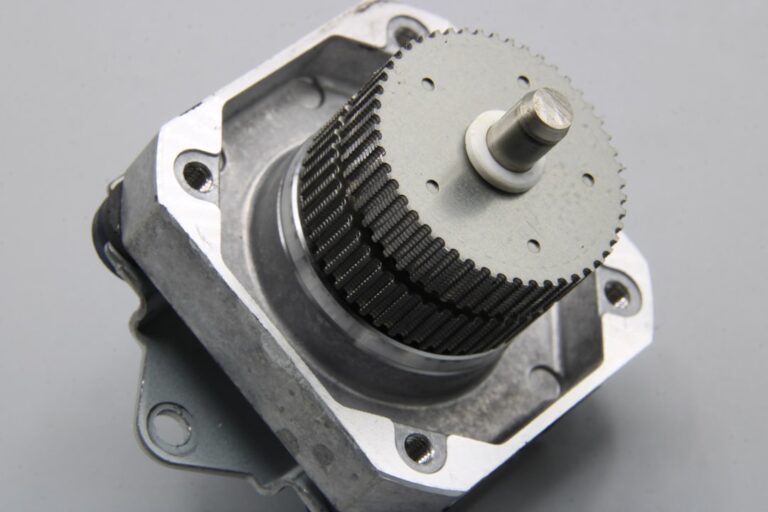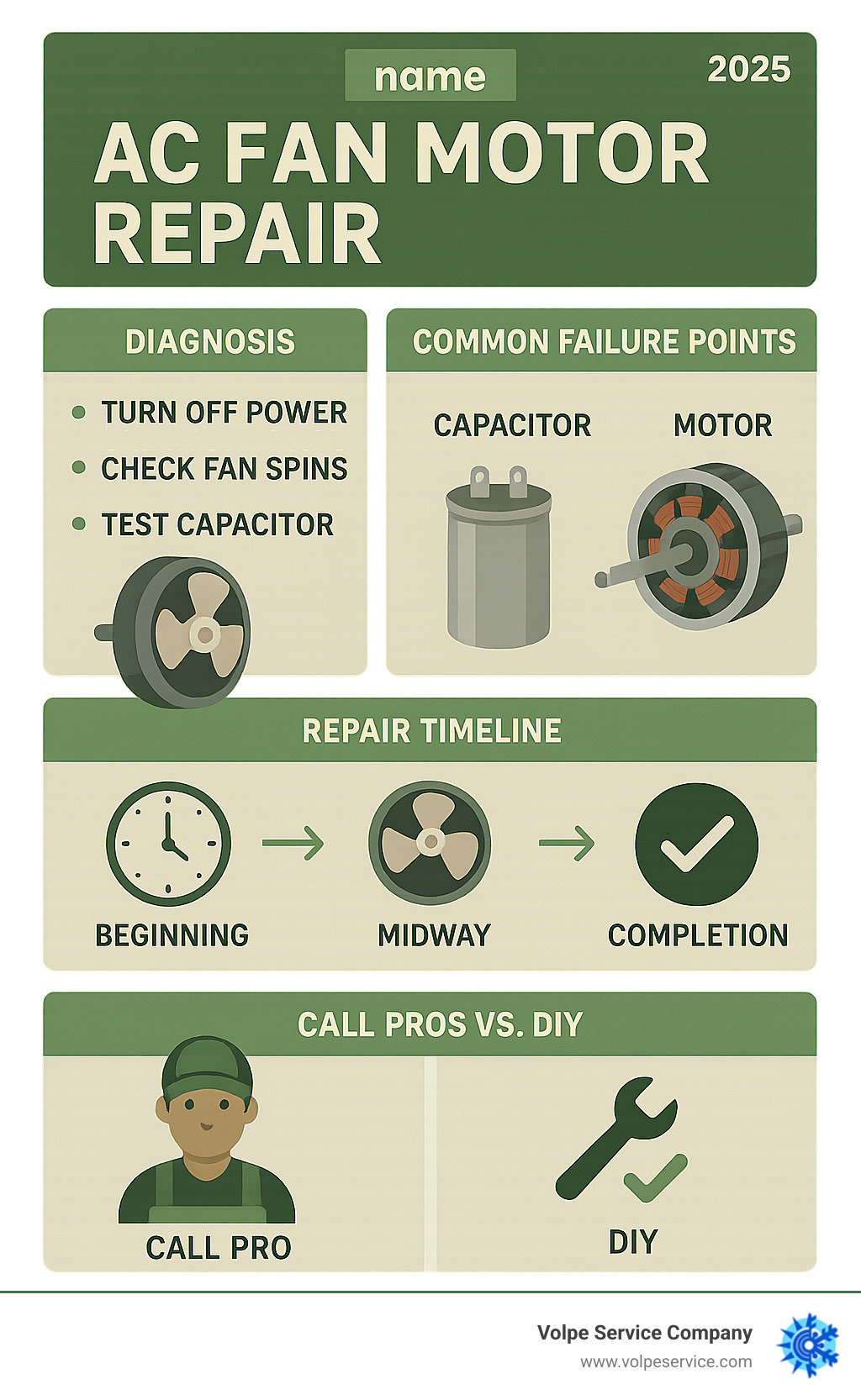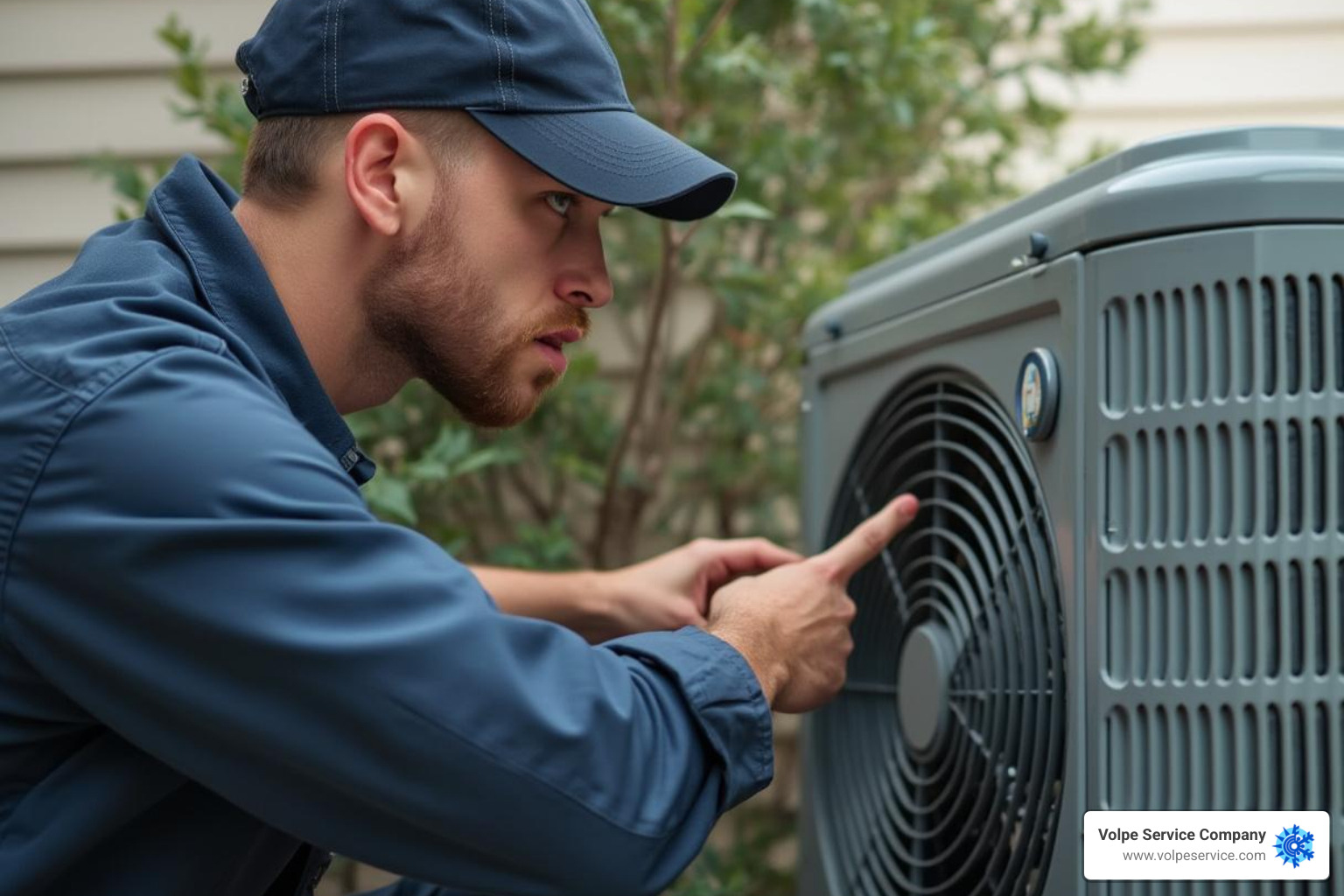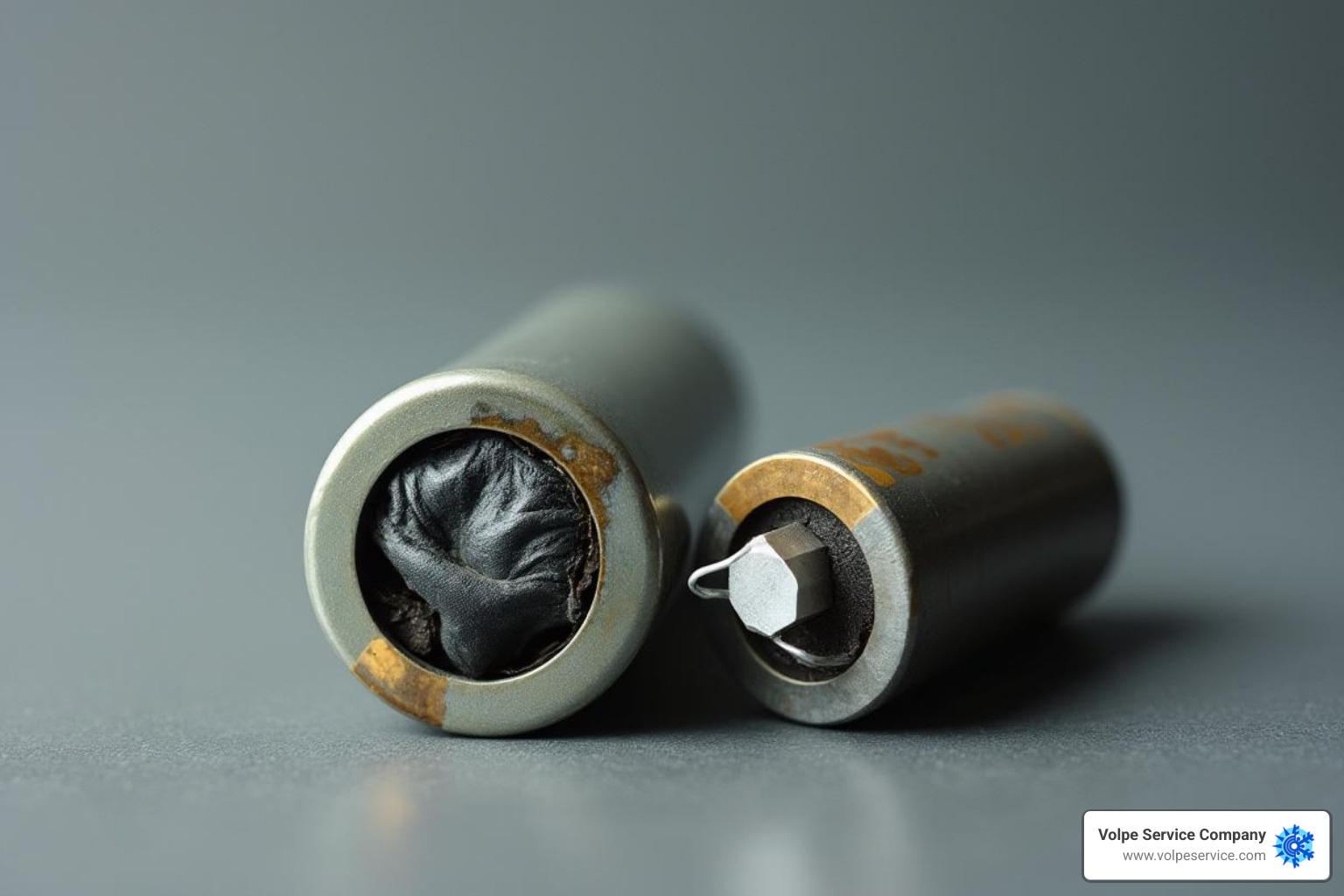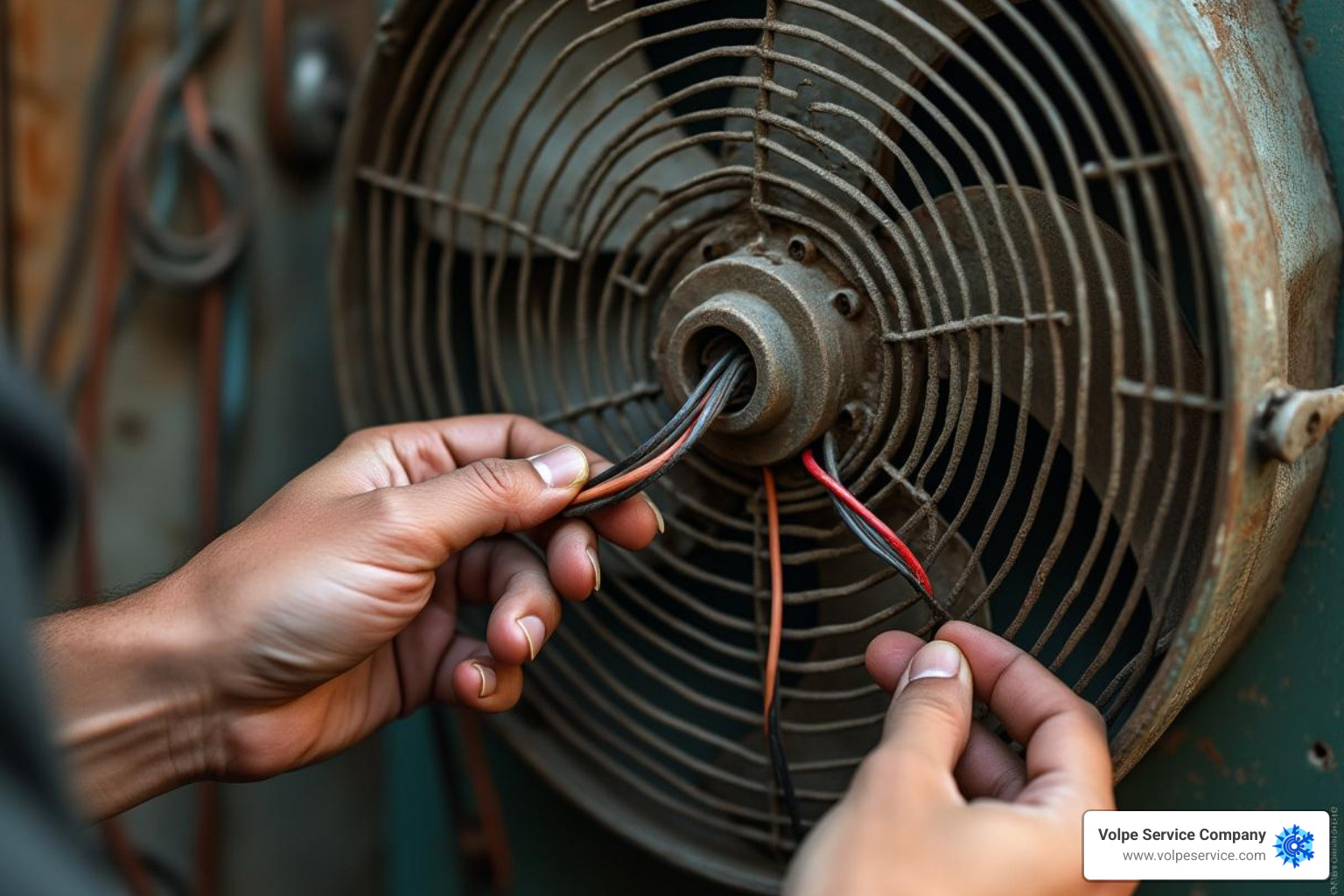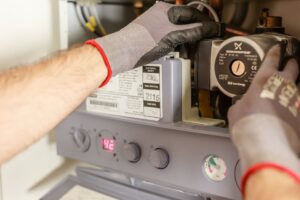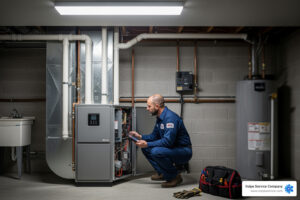Why Your AC Fan Motor is the Heart of Home Comfort
AC fan motor repair is a crucial skill that can save you money and keep your home cool. A failed fan motor can turn your comfortable home into a sweatbox, especially during New Jersey’s humid summers.
Quick AC Fan Motor Repair Guide:
- Safety First – Turn off power at the circuit breaker and disconnect box.
- Diagnose the Problem – Check if the fan spins freely, test the capacitor, and listen for unusual noises.
- Common Issues – A faulty capacitor ($20-30 fix), worn bearings, or complete motor failure.
- Repair Process – Document wire connections, remove the old motor, and install the replacement.
- When to Call Pros – For complex electrical issues, warranty concerns, or safety risks.
Your AC system has two essential fan motors: the outdoor condenser fan removes heat from your home, while the indoor blower circulates cool air. If either fails, your AC unit won’t work.
Often, the problem isn’t the motor itself but a bad capacitor, which costs under $30 to replace. As one homeowner found when their motor wouldn’t start without a manual push, “It was likely a bad capacitor, not the motor.”
Regular maintenance helps these motors last 10-15 years. When they do fail, knowing how to diagnose and repair them can save you significant money.
Understanding Your AC’s Fan Motor and Spotting Trouble
To perform an AC fan motor repair, you first need to understand its role. Your AC doesn’t create cold air; it moves heat from inside your home to the outside using two hardworking fans.
- The indoor blower fan pushes cooled air through your ducts and pulls warm air back to be cooled.
- The outdoor condenser fan blows air over the condenser coils to release captured heat outside.
This heat exchange process relies on proper air circulation driven by the fans. When the refrigerant absorbs heat, both fans must work perfectly to complete the cooling cycle. Knowing the warning signs of a failing motor can help you Identify AC Fan Motor Issues Early and avoid a system breakdown.
Common Symptoms of a Failing AC Fan Motor
When an AC fan motor is failing, it sends out clear distress signals.
- The fan won’t start – The compressor might hum, but the blades don’t move. This often points to a bad capacitor, a dead motor, or a tripped breaker.
- Slow-moving blades – A fan spinning sluggishly indicates a problem and causes the entire system to work harder.
- Humming or buzzing noises – If the motor hums but the blades are still, it’s likely not getting enough power, often due to a bad capacitor.
- Grinding or squealing sounds – These noises usually mean the motor’s internal bearings are worn out and failing from friction.
- Overheating – If the AC unit shuts down unexpectedly or emits a hot, electrical smell, the motor may be overheating.
- Burning smell – This is a serious warning that motor windings are burning. Shut off power at the circuit breaker immediately.
- Tripped circuit breaker – If the breaker trips repeatedly when the AC starts, the fan motor may be drawing too much power due to internal damage.
Catching these symptoms early can save you from a complete system failure. For more details, see our guide on Top Warning Signs: How to Tell if Your Air Conditioner is Broken.
What Causes an AC Fan Motor to Fail?
Understanding the common causes of motor failure can help you prevent them.
- Lack of maintenance is the top cause. Neglecting cleanings allows dust and debris to build up, straining the motor.
- Worn-out bearings fail from age and lack of lubrication, creating friction and heat that cause permanent damage.
- Electrical issues like power surges or faulty wiring can destroy a motor’s internal components.
- Debris and dirt buildup, especially on outdoor units, blocks airflow and leads to overheating.
- Age is an unavoidable factor. Components naturally degrade over 10-15 years, eventually requiring replacement.
Other common culprits include faulty capacitors, bad contactors, and damaged fan blades that create imbalance.
The Capacitor and Contactor Connection
Sometimes, an AC fan motor repair doesn’t involve the motor at all. Two smaller components are often the real villains.
Capacitors act like temporary batteries, providing the electrical jolt your motor needs to start (start capacitor) and run (run capacitor). When a capacitor fails, the motor won’t get the electrical charge it needs. A swollen or bulging capacitor is a dead giveaway. Replacing a capacitor is a much cheaper and simpler fix than replacing the entire motor. Learn more about How capacitors work.
Contactors are heavy-duty switches. When the thermostat calls for cooling, the contactor switch closes to send power to the outdoor unit. If the switch is dirty or worn out, the fan motor gets no power. You can learn How to test an AC contactor to diagnose this issue.
Your Step-by-Step Guide to AC Fan Motor Repair
Ready for a DIY AC fan motor repair? Safety is the top priority. We’re dealing with dangerous electricity, so follow these steps carefully to avoid injury.
Safety first: Always turn off power at two locations: the main circuit breaker for the AC and the outdoor disconnect box. This ensures no electricity can reach the unit while you work.
Gather your tools: screwdrivers, pliers, a multimeter, a socket set, safety glasses, gloves, and a camera or smartphone to photograph wire connections.
For tips on preventing future issues, see our HVAC System Maintenance Tips.
How to Diagnose a Faulty AC Fan Motor
Before replacing parts, confirm the diagnosis to avoid wasting money on a new motor when a cheap capacitor is the real issue.
- Visual Inspection: Look for obstructions like leaves or twigs on the fan blades. Check for bent blades, burnt wires, rust, or physical damage. A swollen or leaking capacitor is a clear sign of failure.
- Spin Test (Power OFF!): With the power completely off, gently spin the fan blades by hand. They should move freely. If they are stiff or make grinding noises, the bearings have likely seized.
- Multimeter Testing: This requires technical skill. For the capacitor test, first safely discharge it with an insulated screwdriver. Then, use a multimeter to check its microfarad (MFD) reading against the rating on its label. A variance of more than 10-20% means it’s bad. To check windings, disconnect the motor’s wires and test resistance between the common, start, and run terminals. A zero or infinite reading indicates a failed motor.
Our guide on How to Know if Your Air Conditioner Needs to Be Repaired offers more diagnostic help.
How to Perform a DIY AC Fan Motor Repair
Once you’ve confirmed the motor is faulty, it’s time for the replacement.
- Document Wire Connections: This is a critical step. Take clear photos of all wire connections before you begin. This will be your guide for installation.
- Remove the Old Motor: With the power off, access the motor by removing the unit’s top grille or side panel. Disconnect the electrical wires. Unbolt the motor from its mounting brackets and lift the motor and fan blade assembly out.
- Remove the Fan Blade: The blade is attached to the motor shaft with a set screw, which may be rusted. Use a penetrating lubricant to loosen it. Note the blade’s exact position on the shaft, as orientation is crucial for airflow.
- Install the New Motor: Slide the fan blade onto the new motor’s shaft in the same position as the old one and secure it. Mount the new motor in the unit.
- Connect Wires: Using your photos and the new motor’s wiring diagram, connect the wires. Ensure all connections are tight and insulated. Universal motors may have extra wires; cap these off with wire nuts.
- Test the New Motor: Reassemble the unit, restore power at the disconnect and breaker, and set your thermostat to cool. If the fan runs smoothly and quietly, you’ve successfully completed the AC fan motor repair.
Choosing the Right Replacement Motor
Selecting the correct replacement motor is essential for a successful repair.
- Model Number: Find the model number on the old motor’s label. An exact match is best, but a universal replacement motor is a good alternative if one isn’t available.
- Motor Specifications: If using a universal motor, match the key specs: Horsepower (HP) (typically 1/8 to 1/2 HP), RPM (revolutions per minute, often 825 or 1075), and Voltage (usually 208-230V for residential units).
- Shaft Size and Rotation: Ensure the shaft diameter and length match so the fan blade fits. Check the rotation direction (clockwise or counter-clockwise); many universal motors are reversible.
- Capacitor Requirements: The new motor may require a different run capacitor. It’s always best practice to replace the capacitor when you perform an AC fan motor repair.
The Cost of Comfort: AC Fan Motor Repair vs. Replacement
When an AC fan motor fails, the first concern is cost. Let’s break down the financial factors involved in an AC fan motor repair.
The final price depends on several factors: the motor type (a basic single-speed motor is cheaper than a high-efficiency ECM motor), labor costs in your area, and your system’s warranty status. Your geographic location, such as Parsippany, NJ, also influences pricing due to market demand and cost of living.
Understanding these variables helps you decide whether to repair the motor or consider a Cost-Effective AC Replacement.
Breaking Down the Costs
For a professional fan motor replacement, homeowners can expect to pay a reasonable range. The total cost includes parts and labor.
- Part Cost: The motor itself can range from under a hundred dollars for a basic model to several hundred for a high-efficiency OEM part.
- Labor Cost: Professional labor often equals or exceeds the part cost, reflecting the technician’s expertise and time for a safe installation.
- Additional Parts: The run capacitor should always be replaced with the motor to prevent the old capacitor from damaging the new motor. This adds a small amount to the total cost.
A DIY repair saves on labor, but a professional AC Repair Service ensures the job is done correctly and safely.
Professional vs. DIY: A Head-to-Head Comparison
Should you do it yourself or call a professional? The choice depends on your skill, experience with electrical work, and risk tolerance.
| Feature | DIY Repair | Professional Repair |
|---|---|---|
| Cost | Lower (part cost only). Saves hundreds in labor. | Higher upfront cost, but includes expertise and warranty. |
| Time | Can take several hours, including diagnosis and part sourcing. | Usually completed in 1-2 hours by an experienced tech. |
| Safety | High risk of electrical shock or injury without proper training. | Minimal personal risk; techs are trained for high-voltage work. |
| Tools | Requires specific tools like a multimeter and knowledge of how to use it. | Technicians arrive with all necessary specialized tools. |
| Warranty | May void system warranty. Part is covered by manufacturer only. | Often includes a labor warranty in addition to the part warranty. |
DIY risks include electrical shock, damaging other components, and voiding your system’s warranty. A misdiagnosis could also mean you replace the wrong part. Professional benefits include an accurate diagnosis, safe installation, and the peace of mind that comes with a guaranteed repair. Learn more about Why Choose Our Technicians for Your AC Needs?.
When to Repair vs. Replace the Entire AC Unit
Is fixing the fan motor the right move, or is it time to replace the whole AC unit? Consider these factors.
- AC Unit Age: Systems last 15-20 years. If yours is over 10-12 years old, replacing the entire unit might be more cost-effective than a major repair.
- Repair Frequency: If your AC needs constant service calls, it’s a sign that multiple components are failing. The costs can add up quickly.
- System Efficiency: Older units use far more energy. A new, high-efficiency system can significantly lower your monthly electric bills, helping to offset the replacement cost.
- Cost-Benefit Analysis: If the cost of repairs is approaching 50% of the cost of a new unit, replacement is usually the smarter long-term investment.
For more guidance, check out our insights on AC Replacement Time.
Frequently Asked Questions about AC Fan Motor Repair
Here are answers to the most common questions homeowners have about AC fan motor repair.
What is the typical cost to replace an AC fan motor?
The cost for an AC fan motor repair or replacement typically ranges from $250 to $800. This includes the motor itself ($100-$700) and professional labor. Costs vary based on motor type (e.g., single-speed vs. multi-speed), location, and whether the part is under warranty. It’s also wise to replace the run capacitor at the same time, which adds a small amount to the total cost.
How long should an AC fan motor last?
A well-maintained AC fan motor should last 10 to 15 years or more. Lifespan depends on usage patterns, climate, and especially maintenance frequency. Regular tune-ups and cleanings are key to longevity. Neglected motors may fail in as little as 8-10 years.
Can a bad fan motor damage other parts of the AC?
Yes, a failing fan motor can cause a domino effect of damage. A bad outdoor fan can cause the compressor to overheat and fail—a very expensive repair. A failed indoor blower can cause the evaporator coil to freeze, leading to water damage and potential coil failure. Both scenarios increase strain and energy bills, shortening the life of the entire AC system. An affordable AC fan motor repair today can prevent thousands in future damages.
Keep Your Cool with Proper Maintenance and Professional Help
While this guide provides the steps for AC fan motor repair, preventing problems through regular maintenance is always better. Simple habits extend your fan motor’s life and ensure system longevity.
- Change Air Filters: Clogged filters strain the motor. Check and replace them monthly during peak season.
- Clear Debris: Keep the area around your outdoor unit clear of leaves, grass, and other debris to ensure proper airflow.
These simple steps are an investment in your comfort and can help you avoid major repairs.
At Volpe Service Company, we’ve been helping New Jersey families stay comfortable since 1963. We combine decades of reliability with modern, data-driven solutions to accurately diagnose and fix issues. When you choose our team, you get guaranteed service from technicians who treat your home with respect.
We understand that your comfort can’t wait, especially during a sweltering summer. Whether you need a fan motor repaired, want to schedule preventive maintenance, or simply need peace of mind, we are here to help.
Ready to give your AC the professional attention it deserves? Schedule your AC maintenance in Parsippany, NJ today, and let our experienced team keep your cool air flowing all season long.


